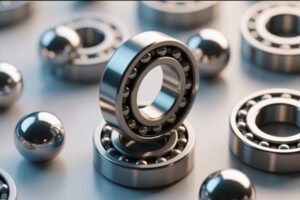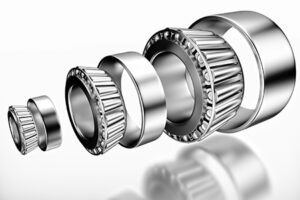Bearings are critical components in mechanical equipment, responsible for supporting and facilitating rotational motion. With the rise of industrial automation and smart manufacturing, bearing technology has been continuously evolving to meet higher performance demands and more complex operating conditions. This article explores the development directions, material innovations, intelligent applications, and future trends in modern bearing technology to help industry professionals and enthusiasts better understand the latest advancements in the bearing field.
1. Background of Bearing Technology Innovation
Traditionally, bearings were primarily made from steel and designed to meet basic rotational and load-bearing requirements. However, as machinery advances towards higher speeds, greater precision, and improved reliability, conventional bearings have shown limitations such as rapid wear, lubrication challenges, excessive noise, and short lifespans. This has made innovation in bearing materials and design concepts a critical industry priority.
2. Application of New Bearing Materials
Material science plays a pivotal role in the advancement of bearing technology. In recent years, various new materials have been applied in bearing manufacturing:
2.1 Ceramic Materials
Ceramic bearings, made from materials like zirconia (ZrO2) and silicon nitride (Si3N4), offer high hardness, excellent wear resistance, corrosion resistance, and lightweight properties. They are widely favored in aerospace, precision instruments, and high-speed motor applications. Ceramic bearings maintain stable performance under extreme temperatures and reduce friction losses, thus enhancing equipment efficiency.
2.2 Stainless Steel and Special Alloys
High-performance stainless steels and alloy materials significantly improve corrosion resistance and fatigue strength. These bearings are particularly suitable for food processing, pharmaceutical, and marine environments. Advances in alloy microstructure have further enhanced mechanical properties.
2.3 Composite Materials and Coating Technologies
The use of composite materials and advanced surface coatings has substantially improved bearing lubrication and wear resistance. Self-lubricating bearings and nano-coatings are increasingly adopted to reduce maintenance frequency and operational costs.
3. Trends in Intelligent Bearings
With the rise of the Industrial Internet of Things (IIoT) and smart manufacturing, intelligent bearings have become a hot topic. Intelligent bearings integrate sensors and monitoring technologies to enable real-time condition detection and predictive maintenance. Key features include:
1.Vibration Monitoring: Built-in accelerometers detect abnormal vibrations to provide early fault warnings.
Temperature Sensing: Continuous temperature monitoring helps prevent overheating damage.
Lifetime Prediction: Big data analytics and machine learning algorithms estimate remaining bearing life to optimize maintenance schedules.
Intelligent bearings improve equipment reliability and significantly reduce unexpected downtime, driving the digital transformation of manufacturing.
4. New Directions in Bearing Design
Modern bearing design trends focus on multifunctionality and high integration, such as:
Composite Structural Design: Combining different materials to create lightweight, high-strength composite bearings for optimized performance.
Modular Design: Simplifying replacement and maintenance to improve production efficiency and lower costs.
Low-Noise Design: Optimizing rolling element shapes and lubrication systems to reduce operational noise, meeting environmental and user experience demands.
These innovations enable bearings to perform exceptionally in aerospace, rail transportation, wind power, and other demanding fields.
5. Future Outlook
The bearing industry is expected to continue evolving toward intelligence, sustainability, and high performance. Key future trends include:
Full Lifecycle Management: Building comprehensive digital systems covering design, manufacturing, use, and maintenance to optimize the entire bearing lifecycle.
Eco-friendly Materials and Processes: Promoting environmentally benign materials and energy-efficient manufacturing to reduce environmental impact.
Cross-disciplinary Innovation: Integrating nanotechnology, artificial intelligence, and novel materials to develop the next generation of high-performance bearings.
Meanwhile, growing global demand for high-quality bearings is driving companies to accelerate technological upgrades and enhance international competitiveness.






